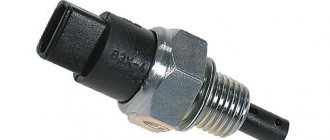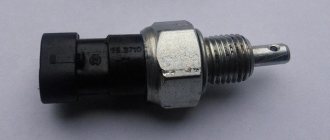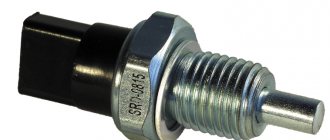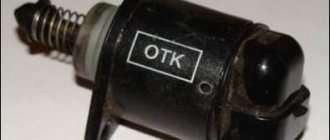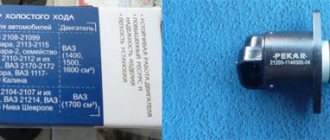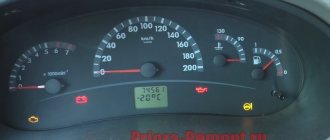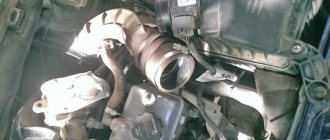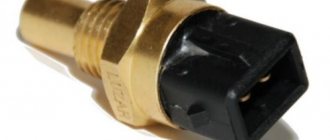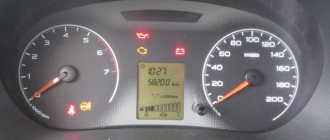Every motorist is most likely aware that one of his most important responsibilities when driving on public roads is to notify other road users of his intention to perform a particular maneuver. For example, to indicate the desire to turn left or right, special indicators are used, controlled by a special lever.
However, progress does not stand still, and some warning signals are given automatically by the machine. A striking example of this is the reverse gear of the car, during which the moon-white rear lights light up automatically and in advance. This happens due to the presence of a special sensor in the design of the car. We will talk about the principles of its operation and repair in the article below.
What is a reverse sensor
Any car has a reverse gear in the gearbox, or, more simply, reverse gear. You can’t do without this function; reverse direction of movement is required when making difficult turns in a limited space, leaving and entering a parking lot (garage), and when crossing off-road conditions. Since the natural position of the driver is directed towards the direction of travel, visibility when reversing is limited. There may be people, vehicles, or stationary obstacles around a vehicle moving backwards. It is necessary to ensure their safety, as well as help the driver navigate difficult driving conditions.
And what about the reverse gear sensor?
Among the safety measures and driver assistance when engaging reverse gear, the following technical means can be listed:
- Reversing lights. They not only illuminate the vehicle's path when reversing. For pedestrians and other road users, the inclusion of white lights on the rear of the car is a signal. Drivers located on the trajectory will be prepared for non-standard movement of the car in front.
- On large vehicles (buses, trucks, special equipment), turning on the reverse is accompanied by a sound signal.
- Activation of parking sensors.
- Turn on the rear view camera, which is the best means of monitoring traffic in blind spots.
How to activate these funds? Activating them manually is dangerous and unreliable; safety devices must be activated automatically. This is why you need a reverse sensor.
From a technical point of view, this is a switch (more precisely, a switch) activated mechanically.
Such limit switches are used not only in cars. When a certain object is moved into the action area of the push rod, the switch contacts close.
And then it’s a matter of technology. You can activate relays to turn on high-power devices, or supply power directly to them. For example, on the reversing lights. Actually, according to their purpose, these sensors are divided into universal (for connecting a number of systems via a relay) or working exclusively in the rear lighting circuit.
How and where to place an advertisement for the sale of a car
A reverse light that doesn't come on is just as potentially dangerous a problem as a reverse light that stays on all the time, even when the car is moving forward.
Therefore, such a problem cannot be ignored under any circumstances. Just like installing a flashing brake light for the sake of beauty. It may look impressive, but it confuses drivers significantly.
In some cases, you can find and eliminate the cause yourself. And without any problems. But there are also situations when the best solution is to visit an experienced auto electrician.
Source
Location of the switch in the car
Where is the reverse sensor located? In principle, it can be placed next to any object that occupies a certain position when reverse gear is engaged. Is the gearshift lever suitable for this? In principle, yes, but moving the handle may not engage reverse gear. And vice versa: reverse gear may be engaged, but for some reason the handle will not take the desired position. It is most reliable to place the sensor itself in the switching mechanism. It is usually located in the gearbox housing.
The sensor rod is moved by the rocker, which is responsible for the position of the reverse drive gear.
Information! Sensors of this type are located only in manual transmissions. In cars with automatic transmission, the signal to turn on the reverse safety systems is provided by another device.
You should know that the mechanical part of the sensor and the threaded connection are actually a plug in the sealed gearbox housing. It contains transmission oil, which can spill out if the seal is broken.
Possible reasons
If the reverse lamps do not turn on when shifting into reverse gear, whether it is manual or automatic, you need to look for the reason.
The light must be on. This will not only result in a fine, but can also lead to a serious accident or accident.
- Sensor malfunction
. It is also a reverse switch, limit switch or frog. This controller is quite reliable and durable. But still, the possibility of its breakdown cannot be ruled out. Especially if the car was hit from behind, the headlight was broken and the lights were changed; - Burnt out light bulb
. Or maybe everything is outrageously banal. Over time, the light bulb has used up its resource, and therefore no longer works. It will have to be replaced; - Fuse
. Also, the signal may disappear if the sensor responsible for these lights burns out. This is a fuse link that burns out when the permissible voltage is exceeded. Since this fuse is responsible for several devices at once in most cars, in parallel with the reverse gear, other lamps, dashboard lights, etc. may not light; - Open circuit
. Here pins can break off, wires can fray, and more; - Oxides and corrosion
. Formed in places where the contacts of the circuit leading to the rear lights are connected; - Ground contact
. If the ground is bad, reverse gear may not function. This is also one of the reasons why the brake lights on a car do not light up.
Unlike the situation when the lamp is constantly on, there are many more potential causes.
But still, the most common problem is the failure of the reverse switch. It is also called a frog.
Types of sensors
By drive type:
- Rod or rod: a movable element in the form of a pin with a large range of movement.
Such an element does not require high mechanical precision, but takes up a lot of space in the gearbox. In addition, it is necessary to ensure tightness: for example, a seal around the rod. - Ball-type: a pressure mechanism in the form of a spring-loaded steel ball.
Small stroke (2–5 mm), high precision required. But the sensor takes up little space and is sealed in design.
By connector type:
- opening pin or knife type contacts;
- closed standard connector with casing for protection against oxidation;
- bayonet swivel connector;
- screw terminals for fastening wires without a connector.
The way the wires are connected is fundamentally unimportant. All types of connections, except open ones, are quite reliable and sealed.
Purpose
Obviously, the car's reverse mode is designed to accelerate the car in the opposite direction without resorting to a 180-degree turn. This allows you to park more comfortably, maneuver faster and, finally, save time for yourself and other drivers.
A reverse signal is needed to warn surrounding drivers of an upcoming maneuver, similar to the way turn signals or brake lights do, embedded in the taillights.
Thus, when reverse gear is activated, a white lamp lights up. All drivers and pedestrians behind are instantly informed that the driver plans to reverse and make decisions about their further maneuvers.
The reverse alarm is also intended for maneuvering in the dark and in fog. The lamp, which has a fairly powerful light beam, allows the driver to better see what is happening behind the car and avoid annoying accidents and incidents when maneuvering. In any case, it is worth paying attention to the condition and operation of the lights. This will eliminate most problems and protect the car from accidental damage.
Sensor failure
The faulty element is identified immediately: the reversing lights and other related devices stop turning on. This problem can also occur due to a broken wiring. How to check the sensor for serviceability?
- Remove the connector, connect the multimeter in dial mode, and engage reverse gear.
- The next step is to unscrew the sensor, connect the device, and press the rod (ball) manually.
Important! When dismantling the sensor, it is necessary to prepare a screw plug to quickly block the hole. Otherwise, oil may leak from the gearbox housing.
- If the sensor itself is operational, you need to check the mechanisms inside the gearbox.
Repairing the reverse sensor is not practical. The case is sealed; after opening it and putting the contact group in order, it will be impossible to restore the structure to its factory condition. The unit is inexpensive, especially on domestically produced cars. Therefore, replacement will not be too expensive.
Important! There is no point in experimenting with selecting sensors from other car models. If the mechanical part is larger than standard, the gearbox may be damaged.
Replacement requires no special tools: just a wrench.
Possible faults
Repairing the reverse sensor is perhaps exactly what no one is immune from. It happens that a unit needs to be replaced only because it simply does not work. How to act in such a situation? First of all, it is important to understand why the sensor is faulty or not working correctly.
Today it is customary to identify the following possible unit malfunctions:
- oxidation of contacts occurred at some point in the electronic circuit;
- the sensor has become “loose” or has failed;
- there was a “breakdown” in the electrical circuit of the identifier;
- contact between the sensor and the mounting block is broken;
- its fuse is blown;
- The rear headlight bulbs ("stopari") have burned out.
The symptoms of a malfunction of the reverse sensor are probably clear to everyone - the corresponding headlights are inoperative or function extremely incorrectly. It is simply unacceptable to operate a car in this condition, so the first thing you should think about when a problem with a unit arises is where the reverse sensor is located and how to repair it correctly. We'll talk about this in more detail below.
Operating principle
The reverse sensor is exactly that device that is designed to activate and turn off maneuver indicators in the form of lamps or LEDs. Its task is to respond instantly when reverse gear is engaged and just as quickly to disengage when moving forward. Moreover, this operating scheme does not depend on the type of transmission, be it manual, automatic or CVT.
Where is the reverse sensor located? Obviously, if the lamp should turn on when the gear shift lever is moved to a certain position, then the sensor itself must be located in the area of the transmission.
Thus, this device consists of an electrical circuit that connects the battery to the lamp.
Obviously, between the battery and the lamp there must be some kind of system that is capable of responding to movements of the gear lever and being activated only when the lever is in reverse or reverse.
This function is performed by a limit switch, which is located along the direction of movement of the automatic transmission selector or on the manual transmission rocker, next to the reverse position point. What is a limit switch? At its core, this is a button that anyone often has to see in real life. Only, unlike most household appliances, this button is activated not directly with a finger, but with the help of a lever that presses it while in a certain position.
When the gearbox is switched to reverse mode, a limit switch powered by the battery is activated. The switch completes the circuit, voltage is applied to the lamp, and it lights up. When you turn off the transmission, in the same way, the button is released and the lamp stops lighting.
Description of IAC
What is the IAC in the Four with an injector, what signs of malfunction are typical for it, where is the device located? You will find answers to these questions with photos and videos below; first, we recommend that you familiarize yourself with the basic information regarding this regulator.
Installation location and purpose
In VAZ 2114 and VAZ 2115 cars, the XX regulator is a device whose purpose is to stabilize the speed of the power unit at idle. The IAC is used to regulate the amount of air flow supplied to the fuel system when the throttle is closed. Accordingly, the engine speed is automatically adjusted. This regulator is located on the throttle body. The device is fixed in the seat using two bolts.
Operating principle
When you turn the key and turn on the ignition, the rod on the IAC extends to the end, as a result of which it rests against the calibration hole on the throttle line. After this, the regulator begins to count steps and returns the valve to its initial state. The position of the original valve directly depends on the firmware of the VAZ control unit. For example, in a car with a January 5.1 control unit on a fully warmed up engine, the number of steps is 120, and in a Bosch it is about 50.
When the power unit is warmed up, at the time of adjustment the IAC is located at around 30-50 steps. When the number of steps increases or decreases, the volume of air flow that passes through the technological opening changes regularly. When the rod extends, the number of revolutions increases, and when it retracts, it drops. The stroke of the rod is about 250 steps. A certain volume of air is supplied to the motor, which is needed for optimal functioning of the power unit.
The amount of supplied air is regulated by a flow meter - mass air flow sensor - in accordance with the volume, the control module supplies a certain amount of fuel to the engine through the injectors. This ensures an optimal ratio of air and fuel when forming a combustible mixture. If the engine is not warmed up, the control module increases the speed thanks to the IAC, which allows you to use the car for driving without warming up the internal combustion engine.
Which regulator is suitable for VAZ 2114 and 2115?
As for the most suitable regulator for the “Four” and “Fifteen”, judging by the reviews, the best option is the IAC Omega. The catalog number of these devices is 2112-114830. In addition, in practice, devices from the manufacturer KZTA have proven themselves well, number 2112-1148300-04. When purchasing, be sure to pay attention to the mark (in this case 04, but IACs with marks 01, 02, 03 are also produced) on the old and new regulator - they must match.
